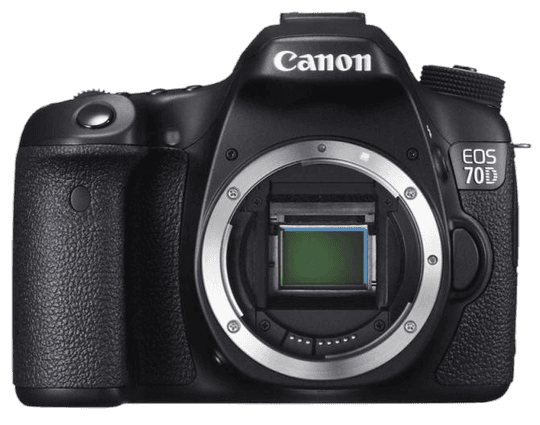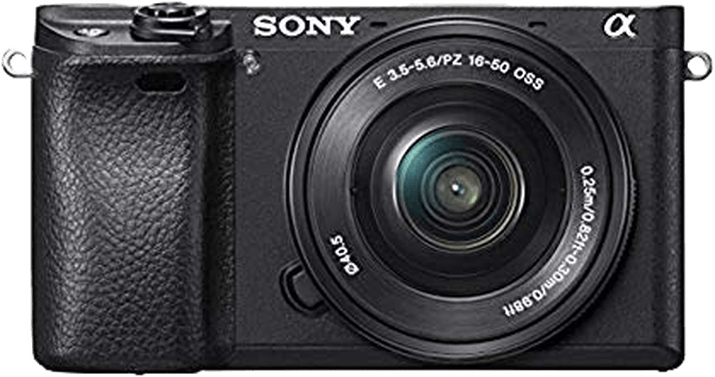Canon EOS 70D vs Sony a6300 Comparison
Canon EOS 70D

Sony a6300

The Sony a6300 narrowly wins over the Canon EOS 70D with a score of 61/100 compared to 60/100. Both cameras were released in the 2010s, with the 70D in 2013 and the a6300 in 2016. They share similarities such as the launch price, with the 70D at $1199 and the a6300 at $1000.
The Sony a6300’s advantages include its mirrorless design, making it lighter at 404g and smaller at 120 x 67 x 49mm compared to the 70D’s weight of 755g and size of 139 x 104 x 79mm. This makes the Sony a6300 more portable and convenient for on-the-go photography.
On the other hand, the Canon EOS 70D’s DSLR design may appeal to those who prefer a more traditional camera feel. Its slightly higher launch price also implies it may have had more premium features at the time of release.
Taking these factors into account, the Sony a6300 comes out ahead as the better camera, but the Canon EOS 70D still has its merits for those who prefer a DSLR design.
Canon EOS 70D vs Sony a6300 Overview and Optics
The Sony a6300 outperforms the Canon EOS 70D in optics with a score of 68/100 compared to the Canon’s 58/100. Both cameras share common specifications such as the CMOS sensor type, APS-C sensor size, and the lack of image stabilization. However, the Sony a6300 proves to be superior in several aspects.
The Sony a6300 has 24.2 megapixels, which is higher than the Canon EOS 70D’s 20.2 megapixels. This results in better image resolution and detail. Additionally, the a6300 has a faster shooting speed of 11 frames per second compared to the 70D’s 7 frames per second, allowing for better performance in capturing fast-moving subjects. The Sony a6300 also has a higher DXOMARK score for the sensor at 85, as opposed to the Canon 70D’s score of 68. This indicates better overall image quality in the a6300.
Despite the lower score, the Canon EOS 70D does have some advantages over the Sony a6300. It features a Canon EF-S lens mount, which provides access to a more extensive range of lenses compared to the Sony E lens mount. This allows for greater flexibility in choosing lenses for various photography needs.
In comparing the optics of these two cameras, the Sony a6300 is the clear winner due to its higher megapixel count, shooting speed, and DXOMARK sensor score. However, the Canon EOS 70D still has merit in its more extensive lens compatibility. Ultimately, the choice between these two cameras will depend on the specific needs and preferences of the photographer.
Canon EOS 70D vs Sony a6300 Video Performance
The Sony a6300 outperforms the Canon EOS 70D in terms of video capabilities, with a significantly higher video score of 91/100 compared to the 70D’s 43/100. Both cameras share some common video specifications, including Full HD resolution and 1920 x 1080 video dimensions. However, the differences between the two cameras become apparent when examining their respective strengths.
The a6300’s superiority in video capabilities is evident through its 4K video resolution, which offers four times the detail of Full HD. Additionally, the a6300 boasts a maximum video frame rate of 120fps, allowing for smoother motion and the option to create slow-motion footage. The inclusion of time-lapse functionality further sets the a6300 apart, providing users with a versatile tool for capturing creative and dynamic video content.
On the other hand, the Canon EOS 70D falls short in comparison, offering only Full HD resolution and a lower maximum video frame rate of 30fps. The absence of built-in time-lapse functionality further limits the 70D’s video capabilities. Despite these shortcomings, the 70D remains a reliable option for those seeking a camera primarily for photography purposes, with video recording as a secondary function.
In comparing the video capabilities of the Sony a6300 and Canon EOS 70D, the a6300 emerges as the clear winner. Its 4K resolution, higher frame rate, and time-lapse functionality make it a superior choice for those prioritizing video recording. The Canon EOS 70D, while reliable for photography, lacks the advanced video features offered by the a6300.
Canon EOS 70D vs Sony a6300 Features and Benefits
The Canon EOS 70D outperforms the Sony a6300 in features, scoring 70 out of 100 points, while the Sony a6300 scores 48 points. Both cameras share a 3-inch screen size, lack GPS, and have WIFI connectivity. However, there are clear differences between the two models that contribute to the Canon EOS 70D’s higher score.
The Canon EOS 70D has a higher screen resolution of 1,040,000 dots, compared to the Sony a6300’s 921,600 dots. This results in a sharper and more detailed display, making it easier to review images and navigate the camera’s settings. Additionally, the Canon EOS 70D has a touchscreen, whereas the Sony a6300 does not. This feature allows for quicker and more intuitive adjustments, as well as the ability to select focus points by touching the screen.
Both cameras have flip screens, but the Sony a6300 does not offer any additional advantages over the Canon EOS 70D in terms of features. The absence of a touchscreen and lower screen resolution make it less convenient to use than its competitor.
Considering the differences in features, the Canon EOS 70D is the better choice for photographers who prioritize a user-friendly interface and a high-resolution display. The Sony a6300, while still a capable camera, falls short in these aspects, making it less appealing to users who value these features. By comparing the specifications of each camera, it is evident that the Canon EOS 70D offers a superior experience in terms of usability and display quality.
Canon EOS 70D vs Sony a6300 Storage and Battery
The Canon EOS 70D outperforms the Sony a6300 in storage and battery with a score of 37/100, while the Sony a6300 only scores 24/100. Both cameras share similarities in storage as they each have a single memory card slot and accept SD, SDHC, and SDXC memory cards. However, the Canon EOS 70D surpasses the Sony a6300 in battery life, offering 920 shots per charge compared to the Sony a6300’s 400 shots. The Canon EOS 70D uses the LP-E6 battery type, while the Sony a6300 uses the NP-FW50 battery type. Neither camera offers USB charging.
The Canon EOS 70D’s longer battery life means users can take more photos without needing to change batteries, making it more convenient for extended shooting sessions. The Sony a6300 falls short in this aspect, potentially causing interruptions during shoots. However, it is important to note that both cameras use the same memory card types, providing equal storage capabilities.
Considering the storage and battery aspects, the Canon EOS 70D proves to be the superior option with its significantly longer battery life, while the Sony a6300 maintains equal storage capabilities but lacks in battery performance.
Canon EOS 70D vs Sony a6300 – Our Verdict
Are you still undecided about which camera is right for you? Have a look at these popular comparisons that feature the Canon EOS 70D or the Sony a6300:

